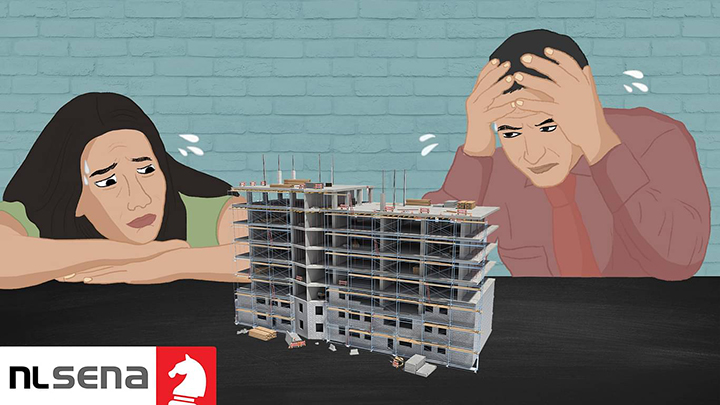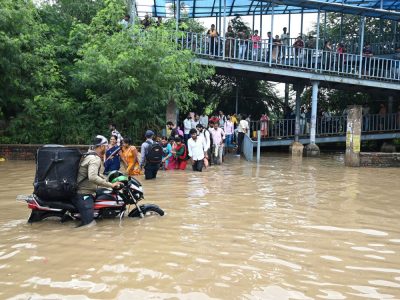The Indian government has given developers at least 19 more months to deliver their projects. For homebuyers, this means a struggle to pay rent and repay loans in these uncertain times as they wait for their dream homes
On March 25, the day India went into lockdown to contain the spread of coronavirus, Hari Nayak was bemused to receive an unexpected email from the developers of Rare Township Pvt Ltd, with an update on the status of a stalled construction project in Mumbai’s Ghatkopar.
Nayak is a homebuyer in Mumbai. He purchased a flat in the Rare Township project called Rising City. The email confirmed his worst fears:
“We shall be able to estimate the revised date of possession only after this extraordinary situation which is not under the control of the promoter, comes back under control and the situation returns to normalcy. In these circumstances the agreement stands modified and possession date(s) stand extended.”
The email settled Nayak’s suspicion that the possession of his 3BHK flat in Rising City would not happen this December — again. In the last two years, the project had faced multiple delays and missed its original delivery deadline of December 2018. Its developers were incommunicado, even blocking the phone numbers of homebuyers like Nayak.
But the Covid pandemic provided Rare Township with the opportunity to surface and blame the lockdown for having “unfortunately again hindered their work and schedule”. The Maharashtra Real Estate Regulatory Authority, or MahaRERA, which is mandated to adjudicate disputes and protect the interests of homebuyers, extended Rising City’s completion deadline to September 2024.
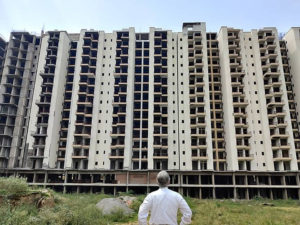
“I feel swindled again,” Nayak said. “At least this time, it’s a good excuse. Last time, they invoked force majeure for failing to get the required aviation clearance from the civic authorities.” Force majeure is a clause invoked due to an event or effect that can be neither anticipated nor controlled.
About 1,400 km away, Ranbir Kaur faced a situation similar to Nayak’s. In March this year, Kaur and her husband were eagerly preparing to get the keys to their house in Jaypee Greens Kensington Park Apartments in Noida’s Sector 133. Then the pandemic hit, swiftly followed by the lockdown.
The Kaurs booked the flat 11 years ago. After multiple delays, they were told the project would finally be ready for delivery by December 2019.
“When December came, we were told to wait a bit longer till February, then again till March,” Kaur said, speaking from her rented home in Gurugram, Haryana, her voice filled with anguish. “Just when we thought we had reached the end of the waiting period, coronavirus happened. The lockdown has once again delayed my dream of moving into our own house.”
Nayak and Kaur are among millions of dejected homebuyers across India, compelled to wait for several more months, perhaps years, before they can secure the ownership of their apartments. And the government has legitimised this delay.
In May, the housing and urban affairs ministry announced that it was treating the pandemic as an event of force majeure, thus giving a blanket extension to all real estate projects for six to nine months. This was over and above the one-year extension granted under Section 6 of the Real Estate Regulation and Development Act.
Many of these projects were already lagging or in limbo for years. Now, the homebuyers face the unfair burden of waiting for at least 19 more months.
According to Anarock, a property consultant, delays will impact at least 15.62 lakh housing units that have been in various stages of construction since 2013 in India’s top seven cities. The hold-up is especially stinging for the homebuyers in the Mumbai Metropolitan Region and the National Capital Region where the real estate sector has been severely impacted. The two urban centres together account for 57 percent of under-construction residential stock in the country, with holdings of 8.6 lakh units.
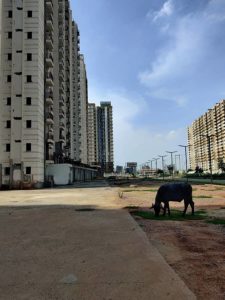
But even before the lockdown, homebuyers had been a worried lot, said Shirish Deshpande, lawyer and chairman of the Mumbai Grahak Panchayat, a consumer grievance redress forum. Defaulting builders had been stopping work midway, delaying monthly rental fees and missing delivery deadlines.
“The lockdown has only aggravated the real estate sector and has become a handy excuse for developers to delay timely completion. They are using earlier catastrophes to justify relief under force majeure,’’ Deshpande said, pointing to the high volume of calls and cases of distressed helpless buyers seeking assistance with the Panchayat’s RERA complaint guidance cell.
Lopsided force majeure
While announcing the relief measures on May 13, housing and urban affairs minister Hardeep Singh Puri said the extension of registration and completion dates of real estate projects as force majeure will “de-stress the sector and ensure completion of projects so that homebuyers are able to get delivery of their booked houses with new timelines”.
But Ravi Gawli, who has been awaiting possession of his 2BHK in Nirmal Lifestyle township on the outskirts of Kalyan since 2016, questioned whether “unscrupulous builders”, who have failed to keep up timely deliveries, deserve the consideration of additional relief.
Nirmal Lifestyle is a project of 30 buildings, including amenities like a tennis court and swimming pool. Launched in 2008, it ran aground after the developer declared financial troubles after the construction of three 15-storey buildings. Gawli and other buyers approached the MahaRERA, which gave the developer a 48-month extension to complete the project by December 2019.
Gawli and the others anticipated a delay but hoped to get delivery by July this year. But under the force majeure relaxation, delivery has been pushed to June 2021. Gawli told Newslaundry that the MahaRERA further gave Nirmal Lifestyle an 18-month extension for about 30 percent construction work remaining.
“The builder is at fault for not keeping up with the timelines, but the government system is equally at fault for not holding the defaulting builders accountable,” Gawli said. “RERA has made all efforts to side with the builders instead of being pro-buyers.”
In January, the Haryana Real Estate Regulatory Authority, or H-RERA, in Gurugram threatened to impose a penalty of Rs 1 crore per day each against two real estate developer, Orris Infrastructure Private Limited and 3C Shelters Private Limited, if they failed to complete the first phase of the much delayed Greenopolis project by April 30. The developers had promised delivery of flats by October 2015.
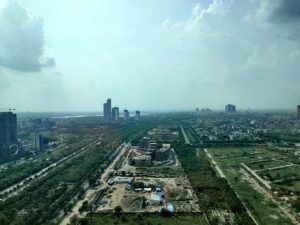
Dimpy Dewan, one of the 1,800 flat buyers of the project, said the developers have not only missed the April mark, but the penalty has also been delayed.
“How can the force majeure be a win-win situation for buyers like us whose homes are delayed by almost half a decade?” she said. “The government should have given an ultimatum to builders: either complete the pending projects in six months, or face coercive action.”
Abhay Upadhyay is a member of the Central Advisory Council under RERA and president of the Forum for People’s Collective Action or FPCA, a pan-India body representing interests of homebuyers. The forum fought to bring in the Real Estate Regulation and Development Act, 2016. He echoed the sentiments of Gawli and Dewan.
“We had objected to the force majeure in the emergency meeting of the Ministry of Housing and Urban Affairs on April 29 but our views were set aside,” he said terming the extension of timelines on project completion as “totally illegal, illogical and unreasonable, definitely not in the spirit of RERA”. This meeting was called by the ministry to discuss the implementation of force majeure as relief to the developers.
The FPCA has demanded that the government protect buyers’ interests, waive interests on home loans, and cancel extensions as it believes that developers can make up for the lost time period once the lockdown is relaxed.
“The manufacturing sector was asked to resume work with 33 percent workforce and not given the benefit of force majeure,” Upadhyay pointed out. “Then why is the real estate sector given the added advantage?” He added that work delayed during the lockdown can be covered within two or three months by ramping up the speed of construction activities.

Redevelopment projects in the lurch
In addition to ongoing construction projects, the lockdown has cast a shadow of uncertainty on redevelopment projects. At one time, Mumbai’s old and dilapidated cess buildings, chawls and slums offered lucrative commercial value for developers to acquire and demolish them, and build brand new structures at a higher floor space index.
Mumbai alone has at least 20,000 old structures, some at extreme risk of collapsing any time, that are in urgent need of redevelopment. These buildings are a death trap for tenants and every monsoon, many of the buildings collapse in the incessant and torrential rains.
Tenants are afraid of handing over these properties for development, however, worried that the developers will abandon the projects midway, leaving them stranded in rented properties at another location for years. The Mumbai Grahak Panchayat’s Shirish Deshpande said many complainants even stopped receiving rent from developers for their alternate accommodation.
While the redevelopment of new buildings is on hold, the lockdown has made precarious even the completion of existing projects.
One such case is the redevelopment of a chawl in Pandurang Wadi in Goregaon, a suburban area of Mumbai.
Vivek Desai spent most of his childhood and adult life in this chawl, living in one room, which includes the kitchen while the toilet is outdoors, with his parents and brother. In 2011, his family and other tenants moved into rented apartments to allow the redevelopment of the chawl. The construction was supposed to have been completed by March 2019.
The first signs of the builder’s financial issues appeared in 2013. The project halted after the plinths and slabs were put up. A few years later, Desai stopped receiving the rent amount to be paid for his family’s alternate accommodation.
“My wife and I pay the Rs 44,000 rent for our flat while there are no signs of our own house getting constructed,” he said, adding that the other owners have repeatedly met and pleaded with the builder to pay their compensation, or to complete the construction and provide them with their own flats. “When there was a real estate boom, he couldn’t finish the construction. And now with lockdown restrictions, it seems impossible any time soon.”
Desai’s 85-year-old mother is one of the original owners of a room in the chawl. He told Newslaundry that he’s worried that his ageing mother will not get to spend her last days in her own house.
“So many of the original house owners like her have died, waiting for the redevelopment to get completed,” he said. “But these emotional stories do not budge the builder.”

Real estate strong army of the economy
The real estate sector is one of the key drivers of the Indian economy, contributing between six and eight percent to the gross domestic product. It’s also among the largest employment generators, providing income to a workforce of over six crore, both directly and indirectly across the supply chain.
The sector is interdependent on everyone from the no-collar seasonal migrant workers from the informal sector putting blood and sweat into the actual construction, crushing stones, baking bricks in kilns, and operating JCBs; to the blue-collar factory workers producing raw materials like concrete, paint, steel, and iron; to retail shop workers selling produce in the semi-formal sector; to the white-collar employees in the formal sector, controlling cash flows in finance, brokering, marketing and mortgage firms.
But during the lockdown, this workforce came undone.
Unregistered skilled and unskilled migrant labourers, earning between Rs 200 and Rs 500 as daily wages, suffered immensely, said Subhash Bhatnagar, coordinator of the National Campaign Committee for Construction Labourers. Although the Centre relaxed rules and permitted construction activities on May 4, construction activities did not begin in full swing.
Outside the hotspot zone in the Mumbai Metropolitan Region, pre-monsoon work restarted at 140 sites that had access to labour, raw materials and machinery. At most other places, thousands of desperate workers joined an exodus to reach home. Many of them travelled on foot, with the initial suspension of public transport across the country.
Between May 1 and June 1, 12 lakh migrants in Maharashtra alone boarded the Shramik Special trains to return to their home states. In Delhi, almost 10 lakh migrants left too. But developers are hopeful that the workers will return to the cities after the monsoon, as they usually do, so work can resume from September.
The real estate sector has been in a downfall since even before the Covid outbreak, thanks to changes brought in by demonetisation, the RERA legislation, GST reforms, amendments to the Insolvency and Bankruptcy Code, and the ban on subvention schemes. The four-month lockdown period exacerbated the situation with developers facing a cash crunch, construction work coming to a halt, millions of labourers without jobs and wages leaving cities, and credit lenders staying overcautious of investments.
In the residential real estate market, there has been a slump of 52 percent and 65 percent in sales and launches, respectively.
In addition, developers in major cities have a pile-up of at least 6.4 lakh units of unsold inventory, which is slow to sell in the absence of physical site visits and the reluctance of buyers to make heavy investments during an economic slowdown.
‘No resolution is forthcoming’
In Delhi-NCR, the situation is serious. One report indicated that developers will require almost four-and-a-half years, or 53 months, to dispose of unsold flats. There have been exceptions, like Mumbai’s Lodha Developers that sold 1,000 units during the lockdown, or a property consulting group claiming it did sales of Rs 318 crore in Mumbai and Thane five weeks after the lockdown began in March.
Yet the slump in real estate, and every additional month of the lockdown, has made a huge hole in the wall. Pankaj Kapoor, managing director of Liases Foras, an independent non-brokerage research firm, assessed that the reduced demand for housing by the end of June would have shrunk the Rs 2 lakh crore market by 33 percent.
This decline is visible on the ground as well. The skylines of Gurugram and Greater Noida, satellite cities flanking Delhi, are dotted with high-rises, with brick or glass exteriors depending on the state of their completion. And yet, there is a sense of emptiness. New and upcoming sectors, created to accommodate the burgeoning population, wear a deserted look as projects and infrastructure remain incomplete.
On December 31, 2019, Dinesh Gupta received the possession letter from the builder of a Noida property that he is invested in. By March 2020, he still had not got the promised handover. Eight months after receiving the letter, Gupta told Newslaundry that he was unsure when he would finally get the keys to his property.
Similarly, in February this year, CM Bhutani was finally intimated that he would get possession of his flat on March 1. The letter from the builder advised him to complete the registration formalities before then. Bhutani had waited 11 years after booking his dream flat but days before he was supposed to move, the builder informed him of a delay in the handover to the end of the month. But Bhutani was thwarted once again, when the lockdown was announced towards the end of March.
Since then, the handover has been postponed several times. It’s now slated for September 8 but multiple calls, emails and even visits to the project site yield little result for Bhutani, Gupta and hundreds of others.
“Even the customer care number remains unanswered,” Bhutani said. Homebuyers are basically in the dark, apart from the fact that their projects need to be “finished”, which is delayed due to the lockdown.
Gupta’s property, for example, is in the AIMS Golf Township in Noida Extension. It has obvious signs of neglect. The decorative palm trees dotting the driveway have died. Certain blocks in the apartment complex are ready, barring the installation of doors, window panes, and other electrical fixtures. A JCB lies still amid a mound of dirt. Ground floor apartments that were accessible show signs of disrepair.
The site looked abandoned, but that didn’t stop the sales and marketing department from attempting to sell the unsold inventory.
“That’s my house,” Gupta said, pointing out an apartment on the seventh floor in one of the blocks. An employee from the sales team said the move would take at least two more months. And while the homebuyers wait, they continue paying rent and EMIs on loans.
Advocate Manish Patni pointed out that the lockdown exacerbated the situation, but the mess was long in the making.
“The current mess would not have been possible without the active participation of the banks. Many homebuyers are stuck with the liability of bank loans and no resolution is forthcoming,” Patni said. “The lockdown has severely affected homebuyers. It is a multiplier effect where people have lost jobs, or their salary has been slashed, but their EMIs and their rent has remained constant.”
He added: “ The big question is, for how long will a homebuyer continue paying the EMIs in fear of affecting their CIBIL credit score? If homebuyers go to court seeking justice, builders will cite the coronavirus to get relief on projects they intentionally delayed.”
Gupta is an investor in real estate, with multiple properties that are stuck in various stages of development. As he said, “Imagine, if someone like me who deals with real estate day in and day out can get stuck, I wonder what a common man is going through.”

Developers demand help to survive
In May, prime minister Narendra Modi announced a Rs 20 lakh crore stimulus package to “save” the economy. Stakeholders in the real estate industry told Newslaundry that this package has nothing in store for their sector, and they’re left to fend on their own.
“Right now, our struggle is primarily to survive as all the developers are under debt and secondly, funds from the government to kickstart the industry,” said Ajay Ashar, a spokesperson of the Maharashtra Chamber of Housing Industry-Credai, an apex body for the state’s real estate developers.
Feeling the heat, some developers have resorted to barter deals: giving flats from unsold inventory to pay off vendor dues. Many have reduced staff salaries or implemented layoffs, given that they’ve started receiving cancellations on flat bookings from hesitant buyers.
Meanwhile, top developers and industry insiders continue to hold webinars with central ministers to discuss the grim situation and convince them to dole out sops for the recovery of the losses. For example, a webinar was organised by the National Real Estate Development Council, or Naredco, a body under the aegis of the Ministry of Housing and Urban Affairs, on the impact of Covid. The council’s president and developer, Niranjan Hiranandani, sought corrective measures including “50 percent cut in GST” which, he said, would be taken care of by deficit financing “in order to instigate the buying of all types of products in the country”.
An online petition by the MCHI-Credai and 35 associations representing real estate developers has demanded the one-time restructuring of loans to reduce economic stress on developers, reduction in home loan interest rate to five percent, reduction in stamp duty, and a one-year extension from RERA on project completion timelines. The petition also asked for an increase in the corpus of the Special Window for Affordable and Mid-Income Housing Fund Investment Fund — approved by the Centre last November to enable the completion of stalled construction of housing projects — from Rs 25,000 crore to Rs 1 lakh crore to boost demand.
In fact, the All India Forum of Real Estate Regulatory Authorities — a new body of all state RERAs — is planning to take the concerns of the MCHI-Credai and Naredco over the liquidity crisis to the Reserve Bank of India for a one-time loan restructuring.
On this, Upadhyay from the FPCA asked Newslaundry: “Why is RERA batting for the developers? Is it their job or even mandate to arrange for their finance? Will they be taking guarantee of payments if the developer defaults?”
Interest rates: EMI developers and buyers
Despite the bad situation, homebuyers feel that developers will eventually make up the losses, along with the market recovering. But homebuyers, on the other hand, have no option of a government bailout or financial relief from banks on home loans, especially at a time when many are dealing with job losses and salary cuts.
Middle-class buyers often shell out savings, mortgage their family gold, take bank loans, and use retirement funds to buy their first homes. When construction is stalled, they suffer the most. Apart from the emotional and mental toll, these homebuyers still have to service the EMIs and interest on their loans, in addition to paying rent for alternate accommodation as their wait for home grows longer.
This is something that Pratik Kothari, a first-time buyer, discovered firsthand in April. Kothari, 25, had purchased a flat in TATA New Haven, an affordable housing project in Bahadurgarh, 33 km from Gurugram. When his move in March was postponed, Kothari, who was already struggling with a reduced salary, opted for a three-month moratorium on his home loan of Rs 50 lakh.
Unfortunately, Kothari did not read the fine print.
“Only later did I realise that this temporary relief will cost me 14 extra EMIs as the interest will go up and the tenure of the loan will be extended,” he said. His loan carries an interest of 8.86 percent. It will take him 240 months, he said, to pay over Rs 1 crore to service the loan with the interest and deferred payment.
Yogita Khanvilkar and her husband have a similar tale of woe. They work in the real estate sector in Mumbai, as an architect and a civil engineer, respectively. In the last nine months, Khanvilkar has received no salary. In April, her firm instituted a 50 percent salary cut.
The couple had booked a flat in Mulund’s City of Joy, a stalled project by Nirmal Lifestyle, in 2009 — one year before they got married. Eleven years and two children later, the flat is nowhere near completion.
“We are running the house on 50 percent of my husband’s salary and previous savings,” she said. “I’m paying an EMI of Rs 45,000 and Rs 18,000 as rent, in addition to our everyday expenses.” She added that she’s lost a decade of her youth due to her worry and stress over the delays in getting possession of the flat, which was due in December 2020. The initial deadline shifted multiple times since 2014.
“I still don’t have a permanent address on my PAN card or ration card,” she said. “Every additional month of delay adds to our sorrow.”
The hardships for the homebuyers do not end here. The banking system, reeling under nearly $140 billion in bad debts, is freshly reassessing accounts of borrowers in light of layoffs and salary deductions, before making fresh disbursements of retail loans. It is likely that defaults for home loans will be in large numbers in the coming months. The reality of the extent of the financial mess in the sector will only surface once the relief period of moratorium is through.
In June, developers received another major protection from the government as it suspended the admission of new cases for defaults on a debt or payment between March and September under the Insolvency and Bankruptcy Code, 2016, for the corporate sector. Effectively, this protects real estate developers as no legal action can be filed for recovery under this code if they default during the six months.
This relief, combined with the six month loan moratorium by the RBI till August 31, will drastically lower the possibility of financial defaults for the developers, giving them a temporary immunity from the banks and non-banking finance companies who would otherwise have invoked insolvency proceedings. The bulk of Indian real estate development is financed by housing finance companies and non-banking finance companies.

Who will blink first?
The Indian realty sector, with Mumbai as the centre point, had a bull run from 2009 until 2013, when global credit lenders made huge investments creating a real estate bubble. The sector thrived on black money, and construction business became the most sought after career option. Mill lands occupying prime property in Mumbai were lapped up by realtors making way for swanky malls, commercial buildings, and high-end apartments in the name of redevelopment. The ubiquitous chawls — the typical residential hallmarks of the city’s burgeoning working class and migrant labourers — were replaced by skyscrapers that now house Bollywood royalty, cricketers, industrialists, corporate honchos and other elites, permanently altering Mumbai’s elusive skyline and social fabric.
Property prices have soared since then to an unaffordable high and were not in sync with the country’s inflation levels. In the last few years, the rates have not increased further, but neither have they come down. Analysts told Newslaundry that the lockdown is providing an opportunity in a crisis that could force the much-needed price correction in the market. It can also lead to the end of business for small- and medium-scale builders who became overnight developers to rake in the profits during the golden years of real estate.
Central ministers like Nitin Gadkari and Piyush Goyal have recommended that developers reduce rates and sell off the inventory in order to bring back the buyers on the market. Kapoor from Liases Foras said that builders need to make at least a 15 percent price reduction, and cut their margins, to revive the current slump.
“Developers will have to let go of past profits and provide discounts to ignite the demand, even if it leads to losses. They have to choose whether to lose money to the lenders or to the buyers on the basis of arbitrage,’’ he said.
This price correction, however, is likely to happen only in the luxury housing segment where prices are upward of Rs 3 crore and developers have higher margins, as against mid-segment and affordable housing. Both the NCR and the Mumbai Metropolitan Region have the highest inventory of such apartments at less than 5,000 units, and builders will have to dispose of this in the near future.
Similarly, Kapoor added that the government will also need to provide incentives in terms of interest exemption, waiving off GST on under-construction property, and waiving stamp duty on house property. According to Liases Foras, these measures will cost around Rs 26,908 crore to the government coffers but will be able to save the industry Rs 5.22 lakh crore. It will also save nearly 2.5 crore jobs and contribute over Rs 1 lakh crore of tax collection.
“The government and developers are waiting to see who will blink first,” Kapoor said. “Under present circumstances, both need to blink and concede losses in the larger interest of the economy.”
While the redevelopment of old dilapidated buildings and slums, and the unveiling of new housing and commercial projects by private realtors, is off for this year at least, some cover-up in revenue will take place from the affordable housing Credit Linked Subsidy Scheme. The project has been greenlighted until March 2021 under finance minister Nirmala Sitaraman’s Atma Nirbhar relief package. The move is expected to benefit 2.5 lakh middle income families as first-time buyers, and lead to investment of over Rs 70,000 crores in the housing sector.
Even as the government and the realty sector gear up for future course correction and bring new buyers on board, existing home buyers like Gawli, Kaur, Dewan, Kothari, Khanwilkar and others — who have invested their life savings into making their homes — remain unsheltered and uncertain.
“Buyers are sincere because their only wish is to have a few square feet of property to call home,” a disconsolate Nayak said. “I sold all my assets, paid the builder and the bank on time, but it’s been an endless wait and I don’t know if I will have my flat after a decade.”
Some names have been changed to protect identities.
www.newslaundry.com
(Cover: credit: Shambhavi Thakur)

